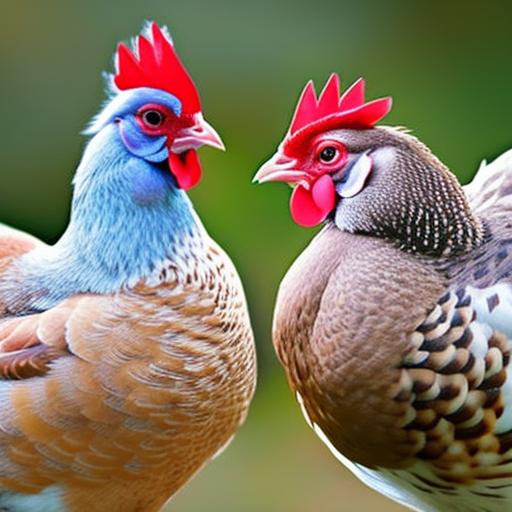Keeping chickens has become increasingly popular in recent years, and for good reason. Not only do chickens provide a sustainable source of fresh eggs, but they also offer a range of other benefits. Chickens are relatively low-maintenance pets that require minimal space and can be a great addition to any backyard or homestead. In addition to their practical benefits, chickens also have fascinating social dynamics that can be both entertaining and educational to observe.
Key Takeaways
- Chickens have complex social dynamics and a pecking order that determines their hierarchy.
- Male and female chickens have distinct physical and behavioral differences.
- Keeping male and female chickens together can provide benefits such as natural breeding and a balanced flock.
- However, there are also risks such as aggression and overbreeding.
- Proper space and resources are crucial for maintaining a healthy mixed flock.
Understanding the Social Dynamics of Chickens
Chickens are highly social animals that thrive in groups. They have a complex social structure that revolves around a pecking order, which determines the hierarchy within the flock. The pecking order is established through a series of interactions and displays of dominance, such as pecking and chasing. This hierarchy is important for maintaining order within the flock and reducing aggression.
Establishing a pecking order is crucial for the well-being of the flock. It helps to minimize aggression and maintain harmony among the chickens. By establishing a clear hierarchy, chickens know their place within the flock and can avoid unnecessary conflicts. Understanding the social dynamics of chickens is essential for successfully managing a mixed flock.
The Differences Between Male and Female Chickens
Male and female chickens, also known as roosters and hens, have distinct physical and behavioral differences. Roosters are typically larger and more brightly colored than hens. They also have larger combs and wattles on their heads. Behaviorally, roosters tend to be more assertive and protective of the flock, while hens are generally more docile and focused on egg-laying.
It is important to understand these differences when keeping a mixed flock. Roosters can provide protection for the hens and help maintain order within the flock. However, they can also be aggressive towards other roosters or humans if not properly managed. Hens, on the other hand, are essential for egg production and can benefit from the presence of a rooster for natural breeding.
The Benefits of Keeping Male and Female Chickens Together
Keeping male and female chickens together in a mixed flock can offer several benefits. One of the main advantages is natural breeding. With a rooster present, hens have the opportunity to mate and produce fertilized eggs. This can lead to a more self-sustaining flock, as hens can incubate and hatch their own chicks.
Another benefit of keeping male and female chickens together is increased egg production. The presence of a rooster can stimulate hens to lay more eggs. Roosters also provide protection for the flock, alerting them to potential dangers and defending against predators.
Having a mixed flock also adds diversity to the flock. Different breeds of chickens have unique characteristics and traits. By keeping both males and females of different breeds, you can create a more diverse and interesting flock.
The Risks of Keeping Male and Female Chickens Together
While there are many benefits to keeping male and female chickens together, there are also some risks that need to be considered. One potential risk is aggression and fighting among the roosters. Roosters can be territorial and may fight with each other for dominance. This can lead to injuries or even death if not properly managed.
Another risk is overbreeding. If there are too many roosters in the flock, they may constantly mate with the hens, leading to excessive breeding and potential health issues for the hens. It is important to have a balanced ratio of roosters to hens to avoid overbreeding.
Keeping male and female chickens together also poses potential health risks. Roosters can transmit diseases or parasites to the hens through mating. It is important to regularly monitor the health of the flock and provide appropriate veterinary care when necessary.
The Importance of Proper Space and Resources

Proper space and resources are essential for maintaining a healthy and harmonious mixed flock. Chickens need enough space to move around freely and establish their own territories. Overcrowding can lead to increased aggression and stress among the chickens.
In addition to space, providing adequate food and water is crucial. Chickens should have access to fresh water at all times, as well as a balanced diet that includes a mix of grains, vegetables, and protein. Ensuring that all chickens have equal access to food and water can help prevent aggression and competition.
Nesting boxes are also important for a mixed flock. Hens need a safe and comfortable place to lay their eggs. Providing enough nesting boxes will help prevent hens from fighting over limited nesting space.
How to Introduce Male and Female Chickens to Each Other
When introducing male and female chickens to each other, it is important to do so gradually. Sudden introductions can lead to aggression and fighting. Start by placing the new chickens in a separate enclosure within the existing flock’s territory. This allows them to see and interact with each other without direct contact.
After a few days, you can begin supervised introductions. Keep a close eye on the chickens’ behavior and be prepared to separate any birds that show signs of aggression. Gradually increase the amount of time the new chickens spend with the existing flock until they are fully integrated.
Signs of Aggression and Dominance in Chickens
It is important to be able to recognize signs of aggression and dominance in chickens in order to manage a mixed flock effectively. Pecking and chasing are common displays of dominance among chickens. This behavior is normal as long as it does not escalate into excessive aggression or injury.
Feather plucking is another sign of aggression in chickens. If one chicken consistently plucks feathers from another, it may be a sign of bullying or dominance. This behavior should be addressed to prevent further aggression.
Vocalizations can also indicate aggression or dominance in chickens. Roosters may crow loudly to assert their dominance, while hens may make loud squawking noises when they feel threatened or challenged.
How to Manage Breeding in a Mixed Flock
Managing breeding in a mixed flock is important to prevent overbreeding and maintain a healthy population. One way to control breeding is through separation. By separating roosters and hens when not actively breeding, you can prevent excessive mating and overbreeding.
If you want to allow natural breeding, it is important to have a balanced ratio of roosters to hens. A general guideline is one rooster for every 8-10 hens. This will help prevent overbreeding and reduce the risk of aggression among the roosters.
If you want to collect and incubate eggs, you can separate the hens into individual nesting boxes and collect the eggs daily. This allows you to control which eggs are incubated and prevents overpopulation.
The Role of Roosters in a Flock
Roosters play an important role in a mixed flock. They provide protection for the hens, alerting them to potential dangers and defending against predators. Roosters also play a crucial role in mating and fertilizing eggs.
However, it is important to note that roosters can also be aggressive, especially towards other roosters or humans. Some roosters may become territorial and attack other birds or even people if they feel threatened. It is important to handle roosters with care and provide them with appropriate outlets for their natural behaviors, such as scratching and dust bathing.
Weighing the Pros and Cons of Mixed Flocks
In conclusion, keeping male and female chickens together in a mixed flock can offer a range of benefits, including natural breeding, increased egg production, and a more diverse flock. However, there are also risks to consider, such as aggression, overbreeding, and potential health issues.
Proper management is key to maintaining a healthy and harmonious mixed flock. Providing enough space and resources, gradually introducing new chickens, and monitoring for signs of aggression are all important aspects of managing a mixed flock successfully.
Ultimately, the decision to keep a mixed flock should be based on individual circumstances and preferences. With proper care and attention, a mixed flock can be a rewarding and enjoyable addition to any backyard or homestead.
If you’re interested in learning more about keeping male and female chickens together, you might find this article on Poultry Wizard helpful. It provides valuable insights into the dynamics of cohabitating male and female chickens, discussing the benefits and challenges that come with it. From understanding the mating season for turkeys to designing the perfect chicken coop and run, Poultry Wizard offers a wealth of information for poultry enthusiasts. Check out their article on chicken coop run plans or explore their guide on turning a shed into a chicken coop for more comprehensive advice.
FAQs
Can you keep male and female chickens together?
Yes, you can keep male and female chickens together.
What is the best ratio of male to female chickens?
The recommended ratio of male to female chickens is one rooster for every 10 hens.
What happens if you keep too many roosters with hens?
Keeping too many roosters with hens can lead to aggression and fighting among the roosters, which can cause injury or death to the hens.
Do male chickens need to be separated from female chickens during breeding season?
No, male chickens do not need to be separated from female chickens during breeding season. However, it is recommended to have a separate breeding pen to ensure successful breeding and to prevent overbreeding.
Can male chickens lay eggs?
No, male chickens cannot lay eggs. Only female chickens have the ability to lay eggs.
What are the benefits of keeping male and female chickens together?
Keeping male and female chickens together can lead to natural breeding, which can result in the production of fertilized eggs for hatching. It can also help to maintain a healthy social dynamic within the flock.
Meet Walter, the feathered-friend fanatic of Florida! Nestled in the sunshine state, Walter struts through life with his feathered companions, clucking his way to happiness. With a coop that’s fancier than a five-star hotel, he’s the Don Juan of the chicken world. When he’s not teaching his hens to do the cha-cha, you’ll find him in a heated debate with his prized rooster, Sir Clucks-a-Lot. Walter’s poultry passion is no yolk; he’s the sunny-side-up guy you never knew you needed in your flock of friends!







